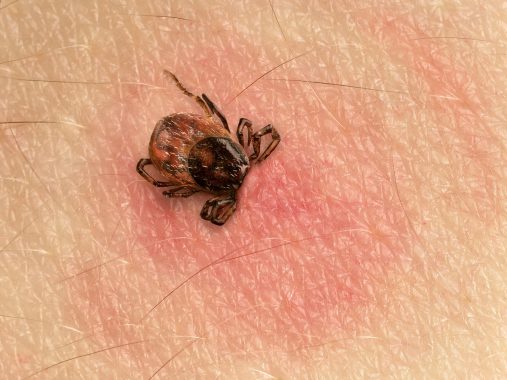GPs should consider starting antibiotics in suspected lyme disease patients without the characteristic circular red rash or confirmed test results, according to the new NICE guidelines.
NICE also informed GPs not rule out Lyme disease in people with ‘no clear history of tick exposure’ if they have potential symptoms, and to diagnose and treat patients presenting with erythema migrans, without further testing.
The new guidelines, which were drafted last year, have told GPs to consider Lyme disease in people presenting with several symptoms such as fever and sweats, fatigue, neck pain or stiffness and headache, as it is a ‘possible but uncommon’ cause.
They said that if there is clinical suspicion of Lyme disease but no erythema migrans, GPs should offer an enzyme-linked immunosorbent assay test and ‘consider starting treatment with antibiotics’ while waiting for the results.
GPs were also told not to ‘rule out the possibility of Lyme disease’ in people with symptoms but ‘no clear history of tick exposure’.
NICE centre for guidelines director Professor Mark Baker said that the advice will lead to earlier diagnosis and ‘provide people with prompt treatment’.
He said: ‘Our committee reviewed the best available evidence and identified gaps in what we know about prevalence in this country and the benefit of long-term treatment options. Further research into Lyme disease should be a high-priority area in the UK so we can continue to improve care.’
Chair of the NICE guideline committee Professor Saul Faust, who specialises in paediatric immunology and infectious diseases at the University of Southampton, added: ‘This new guideline gives more clarity on how clinicians can spot Lyme disease and provide early treatment. It guides through when to use tests and what antibiotics to prescribe according to symptoms.’
Isle of Arran GP and Chair of the Rural GP Association of Scotland Dr David Hogg has welcomed the guidelines, which he said appear to offer ‘clear and pragmatic guidance’ on the assessment of tick bites, and the ‘appropriate treatment steps’.
He said: ‘GPs in rural Scotland see frequent presentations of tick bites, and so far there has been a lack of consistent and helpful guidance on how to manage these cases beyond the consideration of erythema chronica migrans, and early antibiotic use when that is indicated’.
This comes as Pulse revealed that more than 8,000 GPs received a personalised letter informing them that they are over prescribing antibiotics and PHE announced their ambition to half inappropriate antibiotic prescribing by 2020.
Guidelines in full
Consider the possibility of Lyme disease in people presenting with several of the following symptoms, because Lyme disease is a possible but uncommon cause of:
- fever and sweats
- swollen glands
- malaise
- fatigue
- neck pain or stiffness
- migratory joint or muscle aches and pain
- cognitive impairment, such as memory problems and difficulty concentrating (sometimes described as ‘brain fog’)
- headache
- paraesthesia
Do not rule out the possibility of Lyme disease in people with symptoms but no clear history of tick exposure.
Do not diagnose Lyme disease in people without symptoms, even if they have had a tick bite.
Take into account that people with Lyme disease may have symptoms of cognitive impairment and may have difficulty explaining their symptoms. For adults, follow the recommendations in NICE’s guideline on patient experience in adult NHS services.
Diagnose and treat Lyme disease without laboratory testing in people with erythema migrans.
Use a combination of clinical presentation and laboratory testing to guide diagnosis and treatment in people without erythema migrans. Do not rule out diagnosis if tests are negative but there is high clinical suspicion of Lyme disease.
If there is a clinical suspicion of Lyme disease in people without erythema migrans:
- offer an enzyme-linked immunosorbent assay (ELISA) test for Lyme disease and
- consider starting treatment with antibiotics while waiting for the results if there is a high clinical suspicion
If the ELISA is positive or equivocal:
- perform an immunoblot test for Lyme disease and
- consider starting treatment with antibiotics while waiting for the results if there is a high clinical suspicion of Lyme disease
Source: NICE
Pulse October survey
Take our July 2025 survey to potentially win £1.000 worth of tokens

Visit Pulse Reference for details on 140 symptoms, including easily searchable symptoms and categories, offering you a free platform to check symptoms and receive potential diagnoses during consultations.











